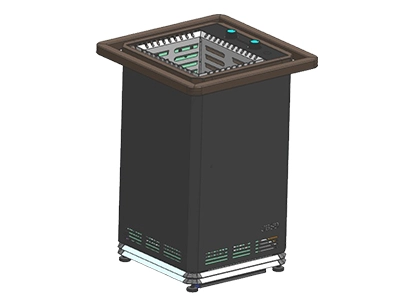

As the pursuit of wellness takes center stage, infrared saunas have emerged as a popular choice for those seeking therapeutic benefits and relaxation. Within the realm of infrared saunas, the choice between carbon and ceramic sauna heaters stands as a pivotal decision. In this comprehensive exploration, we delve into the nuances that define these two infrared sauna heater types, shedding light on the difference between ceramic and carbon infrared saunas.
Understanding Infrared Sauna Equipment
Infrared saunas utilize infrared radiation to directly heat the body, offering a unique and rejuvenating heat experience. Unlike traditional electric sauna stove for sale, infrared saunas penetrate the skin, inducing a deep sweat that is not only detoxifying but also associated with a range of health benefits. The increasing demand for infrared sauna heaters has led to a diverse market, with options ranging from carbon to ceramic variants.
Infrared Sauna Heaters for Sale: Meeting Varied Preferences
The market for infrared sauna heaters is expansive, accommodating a diverse array of preferences and requirements. As consumers explore the available options, the distinction between carbon and ceramic infrared sauna heaters becomes a focal point, influencing the sauna experience in various ways.
1. Heating Mechanism: Carbon's Even Warmth vs. Ceramic's Intensity
Carbon Sauna Heaters: Even Warmth
Carbon sauna heaters utilize carbon fiber panels that emit infrared waves evenly across the sauna space. This results in a gentle and consistent warmth, avoiding concentrated hotspots. Users can enjoy a milder sauna experience, perfect for those who appreciate an evenly distributed heat.
Ceramic Sauna Heaters: Intense and Focused Heat
On the other hand, ceramic sauna heaters employ ceramic rods to generate infrared heat. This technology produces a more focused and penetrating heat, creating an intense sauna experience. The heat from ceramic heaters is often described as robust and invigorating, ideal for those who enjoy higher temperatures.
2. Temperature Range: Carbon's Efficiency vs. Ceramic's High Capability
Carbon Sauna Heaters: Efficient Temperature Control
Carbon heaters are known for their efficiency in reaching and maintaining desired temperatures quickly. They offer precise temperature control, allowing users to customize their sauna experience with ease. This efficiency not only enhances the overall sauna experience but also contributes to energy savings in the long run.
Ceramic Sauna Heaters: High-Temperature Capability
Ceramic heaters have the capacity to reach higher temperatures compared to carbon heaters. This high-temperature capability is appealing to individuals who enjoy a more intense sweat-inducing sauna session. The robust nature of ceramic heaters contributes to a sauna experience described as invigorating.
3. EMF Emissions: Carbon's Low Output vs. Ceramic's Considerations
Carbon Sauna Heaters: Low EMF Emissions
Concerns about electromagnetic field (EMF) emissions are common in the realm of infrared saunas. Carbon sauna heaters are celebrated for their low EMF output, ensuring that users can enjoy the benefits of infrared heat with minimal exposure to electromagnetic fields.
Ceramic Sauna Heaters: Considerations for EMF
While ceramic sauna heaters may have slightly higher EMF emissions than carbon heaters, advancements in technology have led to designs that minimize electromagnetic field exposure. It's advisable to check specific models for their EMF output and choose options that align with personal preferences and health considerations.
4. Construction and Durability: Carbon's Lightweight Panels vs. Ceramic's Robust Structure
Carbon Sauna Heaters: Lightweight Construction
Carbon sauna heaters are often praised for their lightweight construction, making them easier to install and maneuver. The use of carbon fiber panels contributes to the overall portability and flexibility of carbon heaters.
Ceramic Sauna Heaters: Robust and Long-Lasting
Ceramic sauna heaters boast a robust construction, characterized by the use of durable ceramic rods. This durability makes ceramic heaters a long-lasting choice for infrared sauna equipment, capable of withstanding high temperatures over extended periods.
5. Cost Considerations: Carbon's Practicality vs. Ceramic's Investment
Carbon Sauna Heaters: Practical and Cost-Effective
In terms of cost, carbon sauna heaters are often considered more practical and cost-effective. They provide efficient heating without compromising on performance, making them an attractive option for those mindful of budget considerations.
Ceramic Sauna Heaters: Investment in Performance
Ceramic sauna heaters may come with a slightly higher initial cost, reflecting the investment in their performance capabilities and durable construction. For those prioritizing an intense sauna experience and long-term durability, the slightly higher upfront investment may be justified.
6. Ceramic vs carbon heaters: Electromagnetic radiation comparison
Electromagnetic radiation of ceramic sauna heater: The emission of far infrared waves has failed the electronic compatibility test. The use of ceramic sauna has some radiation and harm to the human body.
The heating system of carbon heater for sauna is carbon crystal plate. The outstanding advantage is that there is no attenuation of power after long-term use. Its electromagnetic radiation is relatively small. For some regular carbon heater saunas, the electromagnetic radiation is close to 0. Purchasers need to lock in regular manufacturers, which is an important basis for ensuring safety.
The materials used to make a sauna are crucial because they directly affect the temperature control, durability, health and safety, and overall experience of the sauna. First, high-quality wood has good thermal insulation and durability, which can ensure the structural stability of the sauna at high temperatures and extend its service life. Secondly, certain woods such as cedar have natural antibacterial properties, which can reduce bacterial growth and enhance health and safety. Furthermore, the moisture absorption properties of wood help keep the sauna dry and avoid excessive moisture, thereby preventing mold growth. Finally, high-quality wood can also provide a pleasant touch and natural aroma, which enhances the relaxation effect of the sauna and creates a natural and comfortable indoor environment. The sauna heater is another very important sauna material, as it is needed to provide the best heating effect for the sauna room and ensure that the user gets the best thermal therapy. There are two main types of heaters to consider: carbon and ceramic. Carbon saunas have larger carbon plate heaters that emit even infrared heat and produce high-quality far-infrared wavelength heat, but the energy generated is generally weaker. Ceramic saunas have ceramic heaters that emit a larger amount of infrared heat than carbon plates, but they produce uneven spot heat in the sauna room and produce lower-quality short infrared waves.
Size of Sauna Space
Consider the size of your sauna space. Carbon sauna machine, with their even heat distribution, are well-suited for larger saunas, while the intense heat produced by ceramic heaters may be preferred in more compact spaces.
Desired Sauna Experience
Your personal preferences play a crucial role in choosing between carbon and ceramic sauna heaters. If you lean towards a milder and evenly distributed heat, carbon infrared sauna heaters may align with your preferences. Alternatively, if you enjoy higher temperatures and a more intense sweat, ceramic heaters could be the ideal choice.
Energy Efficiency
Efficiency in energy consumption is a significant factor. Carbon heaters are known for their quick heating and energy-saving capabilities, making them a practical choice for those looking to minimize their environmental impact.
As the journey through the world of infrared sauna heaters unfolds, the difference between ceramic and carbon infrared saunas becomes a matter of tailoring the sauna experience to your unique preferences and requirements. Both carbon and ceramic infrared sauna heaters offer distinct benefits, ensuring a personalized and rejuvenating retreat within the comfort of your sauna space.
When it comes to creating a luxurious sauna retreat, BSD Machine is a trusted name in the industry. With their commitment to quality and innovation, they offer a wide range of steam room equipment that guarantees an exceptional sauna experience.
Electric Sauna Heater for Sale
Dry Sauna Heater: BSD Machine’s dry sauna heaters are designed to provide consistent and efficient heat distribution. These heaters are available in various sizes and power outputs, ensuring that you find the perfect fit for your sauna. With their durable construction and advanced technology, these dry sauna heaters offer long-lasting performance and exceptional heat therapy.
Dry & Steam Sauna Heater: For those who desire the flexibility of both dry and steam saunas, BSD Machine’s dry & steam sauna heaters are an ideal choice. These versatile heaters allow you to switch between dry and steam sauna sessions effortlessly. With precise temperature control and adjustable humidity levels, you can create a customized sauna experience tailored to your preferences.
Mini Sauna Heater: If you have limited space or prefer a more compact sauna, BSD Machine’s mini sauna heaters are the perfect solution. These heaters are designed to fit smaller saunas without compromising on performance. Despite their size, they deliver consistent heat and ensure a relaxing sauna experience.
Sauna Room Accessories: To complete your sauna retreat, BSD Machine offers a wide range of sauna room accessories. From temperature and humidity controllers to sauna stones, buckets, and ladles, these accessories enhance your sauna experience and add a touch of luxury to your space.
• Different Types of Sauna Heaters
• Portable Electric Sauna Heater
• Difference Between Dry and Wet Sauna




